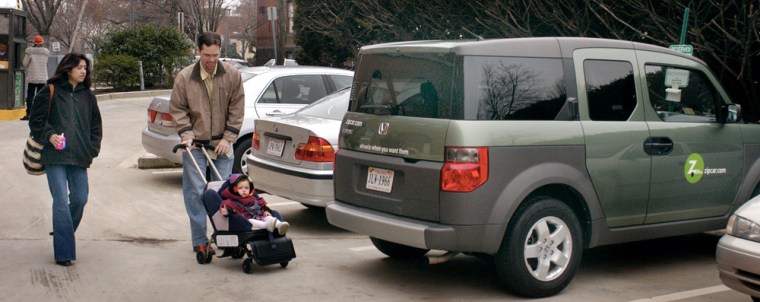If there is a phrase that describes the Zipcar car-sharing service — and I don't think there is yet — it would be some mix of Volkswagen's Fahrvergnügen (driving pleasure) and Napster "Own Nothing, Have Everything" advertising slogan. The experience is what it is all about: I reserve a Mini Cooper online, walk one block from my house in San Francisco to a car lot, swipe my card across the windshield, get in, adjust the seat and mirrors, and motor off. For $11 an hour, my insurance and gas are covered. By block two, I'm thinking of selling my station wagon. Turns out, I'm far from alone. "Forty percent of our customers either sell their car or halt a purchasing decision of a car," says Scott Griffith, Zipcar's CEO.
Griffith, 48, has spent the last decade laying the groundwork for the moment when that question — Would I really get rid of my car? — doesn't sound so crazy. Late last year, Zipcar merged with Flexcar to become the nascent industry's dominant player. The combined company has 180,000 members, who pay at least $50 a year to access cars in 50 cities in the U.S. and the U.K., and is expected to hit $100 million in revenue this year. Integrating the two services should be completed this month.
Revved up for the future
Now Zipcar is ready to shift into second gear driving toward an IPO, 2 million customers, and $1 billion in annual revenue. High oil prices and environmental concerns should ease its path, but even though Zipcar's mission is to take cars off the road, its bid for the mainstream soft-sells the green benefit in favor of the total experience. "We know we're up against an ingrained culture," Griffith admits. "It's a rite of passage to buy a car when you graduate college."
To that end, Griffith's strategy is to intercept customers before then. "We're borrowing from Apple's early days," he says, "when it went after students to be its early adopters." Zipcar is available on 70 college campuses, including such behemoths as Michigan, Ohio State, UNC, and Florida. Griffith expects that number to grow "by a factor of three to five" in the next year or two.
He woos universities to give him prime campus parking spaces as a money-saving hedge against having to build more parking structures. MIT, for example, estimates that it has saved $9 million in capital costs through its alternative-transportation program, which includes Zipcar. Griffith attracts students with cars that they might aspire to own one day, from 3- and 5-Series BMWs to pickup trucks, and the promise of cost savings. "Economics and convenience drive choices, not green," he says, citing that his average customer uses the service two or three times a month, spending less than $100.
The real payoff, then, comes after graduation day. Almost half of Zipcar's college customers move to a major-metropolitan area that Zipcar serves or plans to serve. Many of them continue their membership. "There's a tremendous opportunity to extend that," Griffith says. "We want to fit into a smart, urban lifestyle." The long-term vision is to leverage its lifestyle-brand status to create other revenue streams.
Born during dotcom era
Zipcar was born during the first Web boom and for a long time had the whiff of a dotcom era curiosity. It presciently eschewed check-in counters in favor of a Web- and phone-based reservations system, using digital key-card systems to unlock cars. Now any Web-enabled phone can manage reservations, and the company aims to extend the features it can offer via text messaging as the medium evolves. "Our goal is truly cars on demand," Griffith says.
Ideas on the drawing board include one-way travel between cities and designating cars for longer distances (it now limits how many days in a row you can rent and charges extra for going beyond 180 miles a day). Zipcar is already observing that customers use its service outside of their home market — challenging the rental-car business. "You go to a city for three days, and your rental car sits idle for two and a half," he notes, offering the alternative of simply using a car when you need it. "We think about lifetime membership; rental-car companies focus on transactions."
Indeed, Zipcar may be on a collision course with the Enterprises of the world. "The rental-car companies are feeling — if not exactly heat — some warmth from the car-sharing companies," says car-sharing gadfly Dave Brook. Enterprise, Hertz, and Thrifty now offer hourly options in select cities, and even U-Haul rents PT Cruisers by the hour in 12 markets. "We're fulfilling existing customer short-term transportation needs while also tapping into a whole new customer base," says Hertz marketing VP Frank Camacho.
Griffith considers these moves "an affirmation of how big the category could be." By positioning himself as the Whole Foods of the category, the rental-car companies end up being the grocery stores that add an aisle or two of natural foods. He believes he has got a five-year head start in technology — and, I'd add, he's eons ahead in service. Enterprise still charges extra for insurance. Hertz's sign-up process for hourly rentals in Boston is slow and tedious.
While other companies wrap themselves in green with every modest, earth-friendly nod, Zipcar has adopted a set-it-and-forget-it model. "There is a feel-good component to car sharing, but we let customers come to that conclusion," Griffith says. "We don't have to advertise it." But, hey, it couldn't hurt to come up with a word for that feeling.
